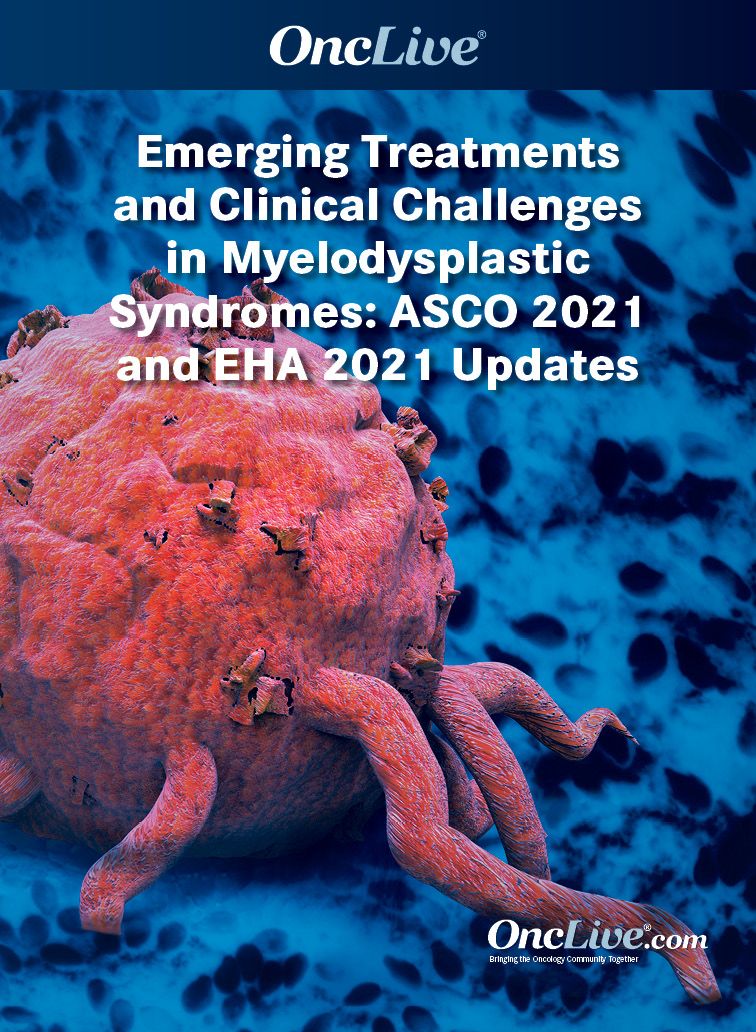Publication
Article
Pevonedistat-Exposure Outcomes Support Recommended Dose in Higher-Risk MDS/CMML and AML
Author(s):
Pevonedistat demonstrated a favorable risk-benefit profile at a dose of 20 mg/m2 in combination with 75 mg/m2 of azacitidine in patients with higher-risk myelodysplastic syndromes/chronic myelomonocytic leukemia and acute myeloid leukemia.

Pevonedistat demonstrated a favorable risk-benefit profile at a dose of 20 mg/m2 in combination with 75 mg/m2 of azacitidine in patients with higher-risk myelodysplastic syndromes (MDS)/chronic myelomonocytic leukemia (CMML) and acute myeloid leukemia (AML), according to findings from a model-based analysis based on data from 3 trials that were presented during the 2021 ASCO Annual Meeting and the 2021 European Hematology Association Congress.1,2
The results showed a consistent clinical benefit across a range of pevonedistat exposures following the recommended starting dose of 20 mg/m2 with regard to event-free survival (EFS), overall survival (OS), complete response (CR), and CR plus partial response (PR).
Pevonedistat is a first-in-class inhibitor of the neural expressed, developmentally downregulated 8-activating enzyme (NAE), explained lead study author Xiaofei Zhou, of Millennium Pharmaceuticals, Inc., in a presentation of the data. NAE inhibition prevents degradation of important proteins and interferes with protein homeostasis, leading to cancer cell death.
In July 2020, the FDA granted a breakthrough therapy designation to pevonedistat for the treatment of patients with higher-risk MDS.3
Pevonedistat plus azacitidine has shown promising activity and safety, without added myelosuppression, in patients with higher-risk MDS/CMML and AML. However, the association between pevonedistat exposure and efficacy and safety outcomes had not been well defined.
To that end, investigators conducted a model-based analysis to determine the relationship between exposure and outcomes to support the dosing regimen of the combination and dose modifications for treatment-related toxicities.
Data from 3 clinical trials––NCT01814826, NCT02782468, NCT02610777––were used in the exposure-response analyses. In each trial, pevonedistat was given on days 1, 3, and 5, and azacitidine was given for 7 days at a dose of 75 mg/m2 in 28-day cycles.
The first phase 1b trial comprised 64 patients with AML. The second phase 1b trial comprised 13 patients with MDS and AML, and the phase 2 trial comprised 58 patients with higher-risk MDS/CMML and low-blast count AML.
Efficacy data included in the exposure-efficacy analyses comprised EFS, OS, CR, and CR plus PR.
Safety data included in the exposure-safety analyses composed febrile neutropenia and grade 3 or higher of the following AEs: neutropenia, thrombocytopenia, alanine aminotransferase elevation, aspartate aminotransferase elevation, infections and infestations, as well as grade 3 or higher TEAEs.
A total of 135 patients were included in the exposure-safety analysis and 58 patients were included in the exposure-efficacy analysis.
The median page age was 74.3 years across the exposure-safety (n = 135), intention-to-treat exposure-efficacy (n = 58), and higher-risk MDS exposure-efficacy (n = 32) cohorts. The majority of patients across all cohorts were male (70.3%), Caucasian (88.3%), had an ECOG performance status of 0 (46.2%) or 1 (45.8%), and had a median Revised International Prognostic Scoring System score of 5.50.
Additional findings illustrated a significant association between pevonedistat exposure and incidence of febrile neutropenia, grade 3 or greater neutropenia, and grade 3 or greater treatment-emergent adverse effects (TEAEs), supporting dose reductions for patients experiencing treatment-related toxicities (P < .05).
“The significant relationship between pevonedistat exposure and hematologic toxicities and grade 3 or higher TEAEs supports the protocol-specified pevonedistat dose modifications to manage treatment-related toxicities,” concluded Zhou.
References
- Zhou X, Mould DR, Zhao D, et al. Model-based analysis to support dose selection of pevonedistat (PEV) combined with azacitidine (AZA) in patients (pts) with higher-risk myelodysplastic syndromes (MDS)/chronic myelomonocytic leukemia (CMML) and acute myeloid leukemia (AML). J Clin Oncol. 2021;39(suppl 15):7042. doi:10.1200/JCO.2021.39.15_suppl.7942
- Zhou X, Mould D, Zhao D, et al. Dose selection of pevonedistat + azacitidine in patients with higher-risk myelodysplastic syndromes/chronic myelomonocytic leukemia and acute myeloid leukemia: a model-based analysis. Presented at: 2021 European Hematology Association Congress; June 9-17, 2021; virtual. Abstract EP928.
- Takeda announces US FDA breakthrough therapy designation granted for pevonedistat for the treatment of patients with higher-risk myelodysplastic syndromes (HR-MDS). News release. Takeda Pharmaceutical Company Limited. July 30, 2020. Accessed June 30, 2021. https://bit.ly/39IYsDS.










